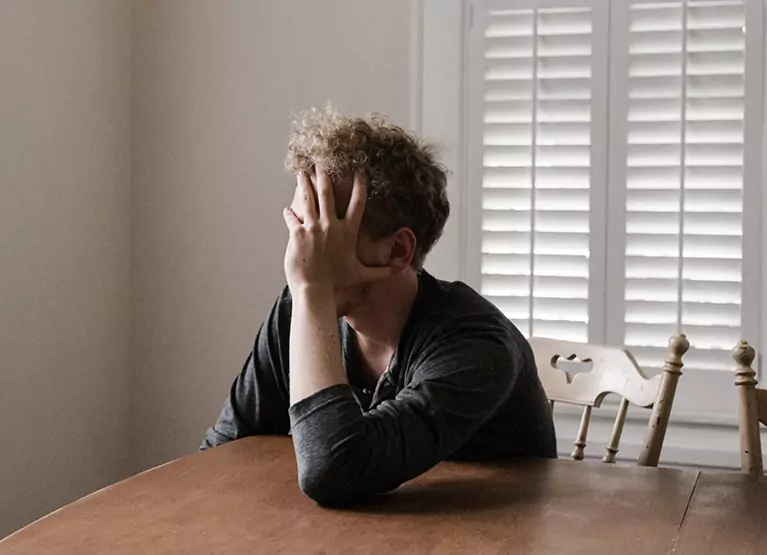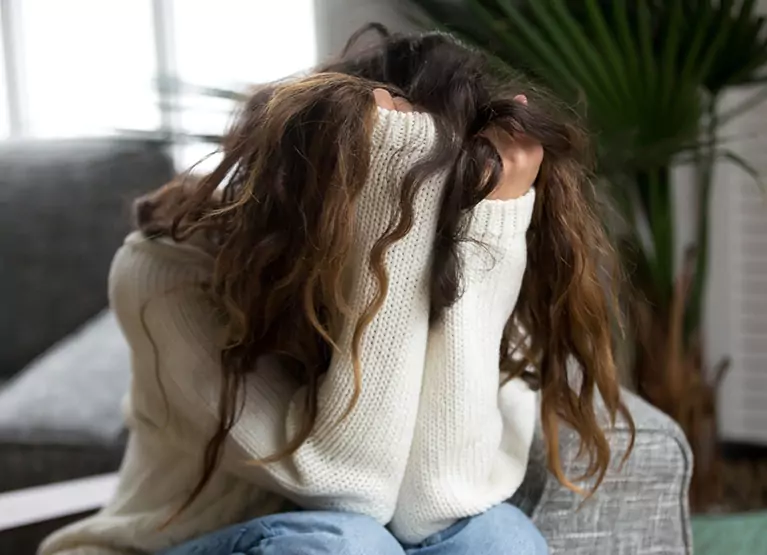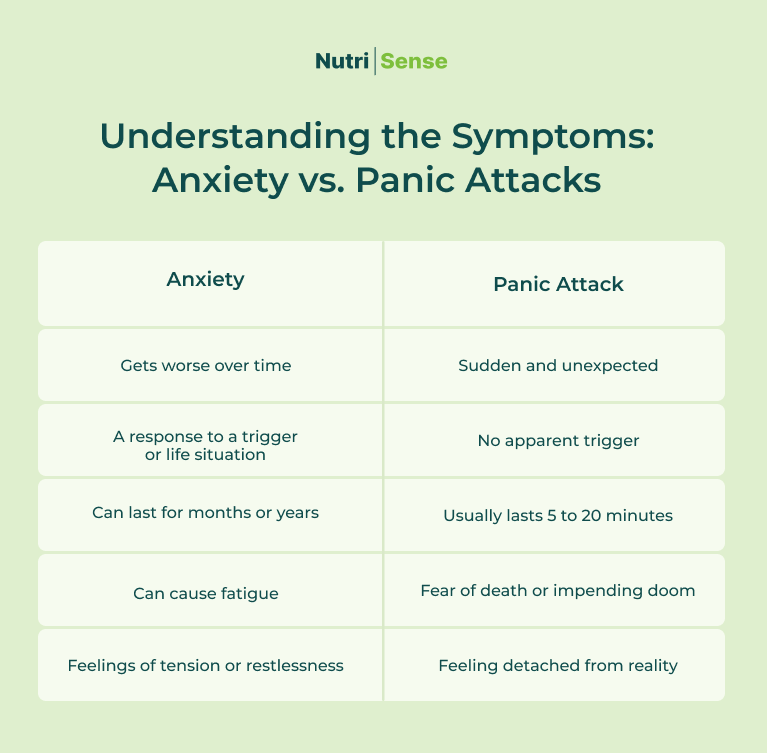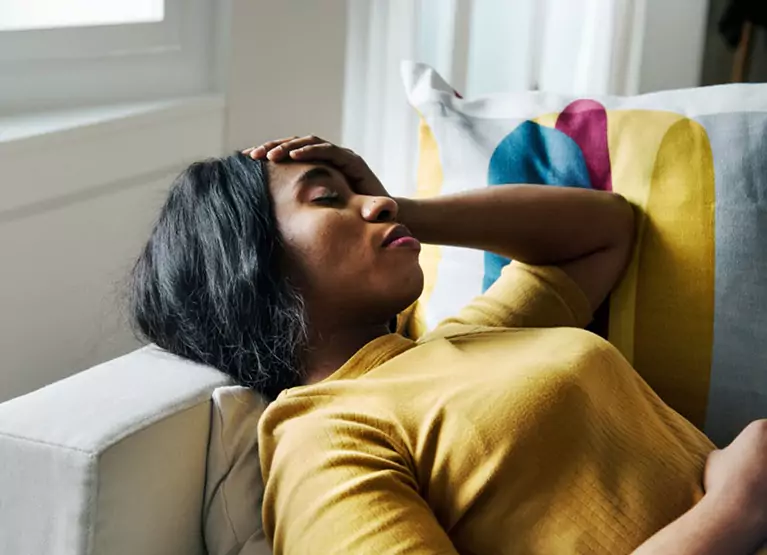Anxiety vs. Panic Attacks: Understanding the Signs and Symptoms

Key Takeways
If you’ve ever experienced symptoms of anxiety, you know that it’s a pretty unpleasant feeling. Unfortunately, this feeling is more common than you might think.
Over 40 million Americans report that they experience symptoms of anxiety. The causes of anxiety can vary and symptoms can present themselves differently in each individual.
Panic attacks are often grouped into the same category as anxiety. However, while they do share similarities, these two distinct experiences have their own sets of symptoms and related disorders.
Read on to learn about the differences between anxiety and panic attacks, how to recognize the signs and symptoms of each, and how to get help if you experience them.
What is Anxiety?
Anxiety disorders are the most common mental illness in the United States, affecting over 19 percent of Americans each year. While experiencing occasional, temporary bouts of worry or nervousness is a natural part of life, some people may experience intense and persistent anxiety that gets worse over time.
Increased levels of anxiety can interfere with daily activities, relationships, and their ability to live a normal, productive life. If your anxiety symptoms begin to affect your everyday life, you may have an anxiety disorder.
Generalized anxiety disorder, social anxiety disorder, and phobia-related disorders are just a few of the most common anxiety disorders that can each have different causes.
Common Symptoms of Anxiety

While anxiety disorders can have different causes, they often share common symptoms. These symptoms include:
- Feeling restless, tense, or on-edge
- Fatigue
- Difficulty concentrating
- Trouble sleeping
- Experiencing headaches, muscle aches, stomachaches, and gastrointestinal problems
- Sweating, trembling, and increased heart rate
- Difficulty controlling feelings of worry
- Taking steps to avoid the situation or thing that is causing you anxiety
Common Anxiety Disorders
There are many different types of anxiety disorders with their own specific sets of symptoms and signs. Here are a few common ones:
Generalized Anxiety Disorder
Generalized anxiety disorder is a persistent feeling of anxiety or dread that can interfere with your everyday life. It differs from occasional, brief bouts of anxiety that may arise due to specific situations or stressful life events.
People with generalized anxiety disorder (GAD) may experience excessive feelings of worry for months or years. GAD is estimated to affect about three percent of the U.S. population and is most commonly seen in women.
Social Anxiety Disorder

Social anxiety disorder involves an intense fear of social situations. It can stem from a fear of being watched or judged by other people.
For some individuals, a fear of social situations can be so intense that it can get in the way of going to work or school, having relationships, and doing everyday tasks. People with this disorder can experience many of the common symptoms of anxiety listed above as well as:
- A rigid body posture or speaking with an overly soft voice
- Difficulty making eye contact
- Difficulty being around people they don’t know
Phobia-related Disorders
Phobia-related disorders involve an intense fear or aversion to specific objects or situations. This fear or aversion is often out of proportion to the actual danger caused by the object or situation.
Common phobias include a fear of flying, fear of blood, fear of receiving injections, and fear of specific animals, like spiders and dogs. These are referred to as specific phobias, or simple phobias.
Other phobia-related disorders include separation anxiety and agoraphobia. People with separation anxiety experience fear of being parted from people they are attached to.
Agoraphobia can cause a fear of being outside of their home alone, being in a crowd, being in enclosed or open spaces, or using public transportation. Individuals with this phobia may go to great lengths to avoid these situations, and even become housebound in severe cases.
Causes of Anxiety

The cause of anxiety disorders aren’t always known, but they may be linked to or triggered by several things. These include:
Underlying Medical Conditions
Some forms of anxiety can be linked to a health issue, like heart disease, diabetes, thyroid problems, chronic pain, or respiratory disorders.
Drug and Alcohol Use
Drug and alcohol use, misuse, or withdrawal can contribute to an anxiety disorder. These substances may also lead to mood swings and similar symptoms.
Medications
Anxiety can be a side effect of some prescription medications like stimulants or steroids. Other medications that are used to treat asthma, Parkinson’s disease, and thyroid conditions have also been linked to anxiety in some people.
Trauma

Adults and children who experience abuse or trauma or witness traumatic events are at higher risk of developing anxiety disorders. Post-traumatic stress disorder (PTSD) and GAD are two common disorders commonly associated with trauma.
Depression and Other Mental Health Disorders
Depression, PTSD, obsessive-compulsive disorder (OCD), adult ADHD, eating disorders, and other mental health conditions can contribute to anxiety disorders. In fact, nearly 50 percent of people diagnosed with depression also have an anxiety disorder.
Family History of Anxiety Disorder
If a family member has an anxiety disorder such as GAD, you may be more likely to develop one of these conditions. Visit your healthcare provider if you have a family history of anxiety disorders and think you may be at a higher risk of developing one.
What is a Panic Attack?

A panic attack is an episode of intense fear accompanied by specific physical symptoms. These episodes usually come on suddenly at unexpected times.
Rather than occurring in response to a specific fear or stressor, panic attacks often don’t seem to have a specific trigger. These episodes are associated with panic disorder, which is a type of anxiety disorder, though not everyone who experiences panic attacks has panic disorder.
Symptoms of Panic Disorder
Panic attacks tend to last between five and 20 minutes, but some have been reported to last up to an hour. The symptoms of panic disorder include:
- Sudden and repeated panic attacks of overwhelming anxiety and fear
- A feeling out being out of control during a panic attack
- A fear of death or impending doom during a panic attack
- Intense worry about experiencing your next panic attack
- Feelings of derealization or depersonalization, which can feel like you are outside of your body.
- Physical symptoms, including:
- Pounding or racing heart
- Sweating and chills
- Trembling
- Difficulty breathing
- Weakness or dizziness
- Tingling or numb hands
- Chest pain
- Stomach pain or nausea
The physical symptoms of a panic attack can sometimes be very similar to the symptoms of a heart attack. If you have panic disorder, the Anxiety and Depression Association of America (ADAA) recommends visiting your doctor to understand your risk of heart attack and distinguish the symptoms.
Causes of Panic Disorder

The cause of panic attacks and panic disorder isn’t known, though they may be linked to the following risk factors.
Genetics
A family history of panic attacks or panic disorder may increase your risk of developing panic disorder. This link is still being studied to determine how genes can lead to this disorder.
Trauma or Major Stress
Traumatic events like sexual assault or serious accidents, or major stressors like serious illness or death of a loved one can contribute to the development of panic disorder. Disorders such as PTSD can lead to panic attacks in some individuals, for example.
Major Life Changes
Major changes like divorce or having a baby may be linked to panic disorder. However, scientists note that this connection is still being observed and that more research is required to determine the link.
Smoking or Excessive Caffeine
Smoking or drinking excessive amounts of caffeine may contribute to panic disorder. Individuals who experience the symptoms of panic attacks may want to avoid doing these things.
Recognizing the Difference Between Anxiety and a Panic Attack
If you are wondering whether you are experiencing anxiety or having a panic attack, check your symptoms:

Treatment for Anxiety and Panic Disorder
If you experience anxiety or panic disorder, there are a few treatment options you may want to consider depending on your symptoms.
Therapy Treatment
Cognitive Behavioral Therapy (CBT)
CBT is often used in individuals with anxiety and teaches people that they can change their way of thinking, behaving, and reacting to situations. This treatment is often helpful in improving quality of life and may help lessen your response to stressors and triggers of fear and anxiety.
Acceptance and Commitment Therapy
Acceptance and Commitment Therapy is a type of therapy that uses strategies like mindfulness and goal setting to reduce anxiety and stress. It’s been found to have a positive effect for individuals with many forms of anxiety disorders.
Nutrition Therapy
There’s a growing body of research that has started to examine the underlying metabolic dysfunctions associated with anxiety symptoms. Studies are still exploring the gut-brain connection and how the gut microbiota is linked to mental health and mood disorders.
Certain diet choices like limiting added sugar, increasing omega-3, turmeric and vitamin D intake are all being studied to determine how nutrition can be used as a metabolic treatment for conditions such as anxiety.
Medication for Treating Anxiety

Medication is often a safe and effective option for treatment for anxiety disorders. This form of treatment is often combined with therapy, and may be used as a long-term or short-term treatment option.
Your doctor or psychiatrist can prescribe anxiety medication if they feel it is needed, but it can often take time and patience to determine the best medication for your anxiety. There are four types of medication that are used to treat anxiety disorders:
Selective Serotonin Reuptake Inhibitors, or SSRIs
SSRIs block the reabsorption of serotonin by certain nerve cells in the brain. This makes more serotonin available for the brain, which can improve your mood and have a positive effect on individuals with anxiety.
Serotonin-Norepinephrine Reuptake Inhibitors, or SNRIs
SNRIs increase the levels of serotonin and norepinephrine levels by blocking the reabsorption of them by the cells in your brain. SNRIs are considered as effective as SSRIs.
Benzodiazepines

Benzodiazepines are usually used for short-term treatment of anxiety, or as an add-on treatment to other medications. They help promote relaxation and reduce physical symptoms of anxiety, but long-term use can lead to dependence.
Tricyclic Antidepressants
Tricyclic antidepressants are effective in treating anxiety disorders, and do not produce the long-term dependence that benzodiazepines do. However, researchers usually recommend SSRIs for use in patients with anxiety disorders.
If you think medication may be an effective treatment for you, talk to your doctor or psychiatrist. They can help you determine the correct medication and dosage for your specific symptoms, and talk to you about the risk of potential side effects.
Tips for Managing Anxiety at Home
There are some techniques you can use to manage anxiety in your everyday life. The ADAA suggests these tips for managing your anxiety at home:

- Listen to music, meditate, or learn relaxation techniques to help ease symptoms
- Eat healthy, well-balanced meals
- Limit alcohol and caffeine, which can make anxiety worse and trigger panic attacks
- Get good, healthy sleep
- Exercise daily
- Practice slow, deep breathing techniques
- Try to identify what triggers your anxiety by keeping a journal
- Talk to your friends and family when you feel anxious or overwhelmed
Find the right Nutrisense programto turn insight into progress.
Go Beyond Glucose Data with Nutrisense
Your glucose can significantly impact how your body feels and functions. That’s why stable levels are an important factor in supporting overall wellbeing. But viewing glucose isn't enough. Nutrisense, you’ll be able to learn how to use your body's data to make informed lifestyle choices that support healthy living.
One-to-one coaching
Sign up to access insurance-covered video calls to work with a glucose expert: a personal registered dietitian or certified nutritionist who will help tailor your lifestyle and diet to your goals.
Monitor and measure what matters
With the Nutrisense CGM Program, you can monitor your glucose with health tech like glucose biosensors and continuous glucose monitor (CGM)s, and analyze the trends over time with the Nutrisense App. This will help you make the most informed choices about the foods you consume and their impact on your health.
Find your best fit
Ready to take the first step? Start with our quiz to find the right Nutrisense program to help you take control.

Heather is a Registered and Licensed Dietitian Nutritionist (RDN, LDN), subject matter expert, and technical writer, with a master's degree in nutrition science from Bastyr University. She has a specialty in neuroendocrinology and has been working in the field of nutrition—including nutrition research, education, medical writing, and clinical integrative and functional nutrition—for over 15 years.




